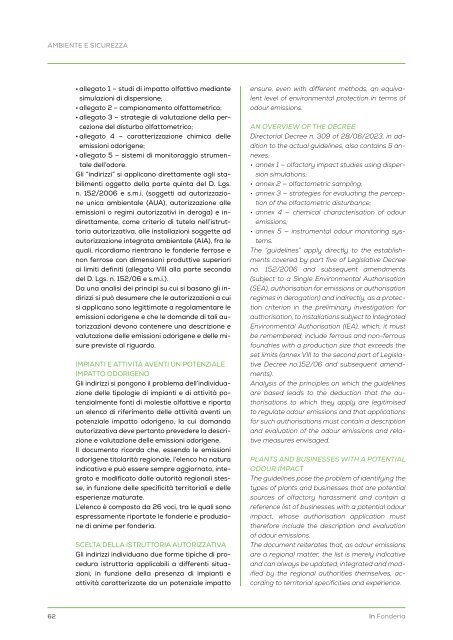In Fonderia 1 2024
Primo numero del 2024 di In Fonderia
Primo numero del 2024 di In Fonderia
Create successful ePaper yourself
Turn your PDF publications into a flip-book with our unique Google optimized e-Paper software.
AMBIENTE E SICUREZZA<br />
• allegato 1 – studi di impatto olfattivo mediante<br />
simulazioni di dispersione;<br />
• allegato 2 – campionamento olfattometrico;<br />
• allegato 3 – strategie di valutazione della percezione<br />
del disturbo olfattometrico;<br />
• allegato 4 – caratterizzazione chimica delle<br />
emissioni odorigene;<br />
• allegato 5 – sistemi di monitoraggio strumentale<br />
dell’odore.<br />
Gli “indirizzi” si applicano direttamente agli stabilimenti<br />
oggetto della parte quinta del D. Lgs.<br />
n. 152/2006 e s.m.i. (soggetti ad autorizzazione<br />
unica ambientale (AUA), autorizzazione alle<br />
emissioni o regimi autorizzativi in deroga) e indirettamente,<br />
come criterio di tutela nell’istruttoria<br />
autorizzativa, alle installazioni soggette ad<br />
autorizzazione integrata ambientale (AIA), fra le<br />
quali, ricordiamo rientrano le fonderie ferrose e<br />
non ferrose con dimensioni produttive superiori<br />
ai limiti definiti (allegato VIII alla parte seconda<br />
del D. Lgs. n. 152/06 e s.m.i.).<br />
Da una analisi dei principi su cui si basano gli indirizzi<br />
si può desumere che le autorizzazioni a cui<br />
si applicano sono legittimate a regolamentare le<br />
emissioni odorigene e che le domande di tali autorizzazioni<br />
devono contenere una descrizione e<br />
valutazione delle emissioni odorigene e delle misure<br />
previste al riguardo.<br />
IMPIANTI E ATTIVITÀ AVENTI UN POTENZIALE<br />
IMPATTO ODORIGENO<br />
Gli indirizzi si pongono il problema dell’individuazione<br />
delle tipologie di impianti e di attività potenzialmente<br />
fonti di molestie olfattive e riporta<br />
un elenco di riferimento delle attività aventi un<br />
potenziale impatto odorigeno, la cui domanda<br />
autorizzativa deve pertanto prevedere la descrizione<br />
e valutazione delle emissioni odorigene.<br />
Il documento ricorda che, essendo le emissioni<br />
odorigene titolarità regionale, l’elenco ha natura<br />
indicativa e può essere sempre aggiornato, integrato<br />
e modificato dalle autorità regionali stesse,<br />
in funzione delle specificità territoriali e delle<br />
esperienze maturate.<br />
L’elenco è composto da 26 voci, tra le quali sono<br />
espressamente riportate le fonderie e produzione<br />
di anime per fonderia.<br />
SCELTA DELLA ISTRUTTORIA AUTORIZZATIVA<br />
Gli indirizzi individuano due forme tipiche di procedura<br />
istruttoria applicabili a differenti situazioni,<br />
in funzione della presenza di impianti e<br />
attività caratterizzate da un potenziale impatto<br />
ensure, even with different methods, an equivalent<br />
level of environmental protection in terms of<br />
odour emissions.<br />
AN OVERVIEW OF THE DECREE<br />
Directorial Decree n. 309 of 28/06/2023, in addition<br />
to the actual guidelines, also contains 5 annexes:<br />
• annex 1 — olfactory impact studies using dispersion<br />
simulations;<br />
• annex 2 — olfactometric sampling;<br />
• annex 3 — strategies for evaluating the perception<br />
of the olfactometric disturbance;<br />
• annex 4 — chemical characterisation of odour<br />
emissions;<br />
• annex 5 — instrumental odour monitoring systems.<br />
The “guidelines” apply directly to the establishments<br />
covered by part five of Legislative Decree<br />
no. 152/2006 and subsequent amendments<br />
(subject to a Single Environmental Authorisation<br />
(SEA), authorisation for emissions or authorisation<br />
regimes in derogation) and indirectly, as a protection<br />
criterion in the preliminary investigation for<br />
authorisation, to installations subject to <strong>In</strong>tegrated<br />
Environmental Authorisation (IEA), which, it must<br />
be remembered, include ferrous and non-ferrous<br />
foundries with a production size that exceeds the<br />
set limits (annex VIII to the second part of Legislative<br />
Decree no.152/06 and subsequent amendments).<br />
Analysis of the principles on which the guidelines<br />
are based leads to the deduction that the authorisations<br />
to which they apply are legitimised<br />
to regulate odour emissions and that applications<br />
for such authorisations must contain a description<br />
and evaluation of the odour emissions and relative<br />
measures envisaged.<br />
PLANTS AND BUSINESSES WITH A POTENTIAL<br />
ODOUR IMPACT<br />
The guidelines pose the problem of identifying the<br />
types of plants and businesses that are potential<br />
sources of olfactory harassment and contain a<br />
reference list of businesses with a potential odour<br />
impact, whose authorisation application must<br />
therefore include the description and evaluation<br />
of odour emissions.<br />
The document reiterates that, as odour emissions<br />
are a regional matter, the list is merely indicative<br />
and can always be updated, integrated and modified<br />
by the regional authorities themselves, according<br />
to territorial specificities and experience.<br />
62<br />
<strong>In</strong> <strong>Fonderia</strong>














